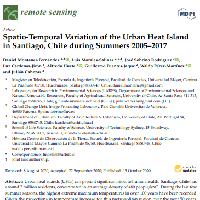Resumen
- Urban heat islands (UHIs) can present significant risks to human health. Santiago, Chile has around 7 million residents, concentrated in an average density of 480 people/km2. During the last few summer seasons, the highest extreme maximum temperatures in over 100 years have been recorded. Given the projections in temperature increase for this metropolitan region over the next 50 years, the Santiago UHI could have an important impact on the health and stress of the general population. We studied the presence and spatial variability of UHIs in Santiago during the summer seasons from 2005 to 2017 using Moderate Resolution Imaging Spectroradiometer (MODIS) satellite imagery and data from nine meteorological stations. Simple regression models, geographic weighted regression (GWR) models and geostatistical interpolations were used to find nocturnal thermal differences in UHIs of up to 9 °C, as well as increases in the magnitude and extension of the daytime heat island from summer 2014 to 2017. Understanding the behavior of the UHI of Santiago, Chile, is important for urban planners and local decision makers. Additionally, understanding the spatial pattern of the UHI could improve knowledge about how urban areas experience and could mitigate climate change.
